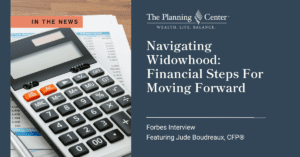
Andy Baxley, CFP®, CIMA®, Sr Financial Planner
Here at The Planning Center, we focus a lot of our energy on transitions planning. In the financial planning context, transitions can be defined as major life events with significant financial and emotional complexity, such as marriage, retirement, starting (or selling) a business, divorce, and the death of a loved one.
Sometimes transitions are imbued with possibility and opportunity. Other times they mark the end of an era or plunge us into a state of grief and sadness.
Having worked with inheritors for over two decades, we’ve found receiving an inheritance to be among the more emotionally nuanced of all the major life transitions. Receiving an inheritance is neither a purely positive nor purely negative event. Inheritance represents possibility and loss, opportunity and sadness.
It’s enough to make your head spin in the best of times. When you’re in the throes of grief, the added technical complexity can lead to all kinds of challenges. It is normal to feel…
- Overwhelmed
- Conflicted
- Guilty
- Alienated
- Excited
- Paralyzed
- Optimistic
- Anxious
- Grateful
- Depressed
- Confused
- Relieved
The first step to take when you’ve received an inheritance is simply to accept whatever you’re feeling as normal. If you’re struggling with complicated, conflicted thoughts, you are not alone.
The second step is to establish a connection with a team of trusted professionals who are equipped to handle the complexities of what you’re dealing with. Depending on your situation, you will likely need to consult a financial planner, an accountant, and an attorney.
You will want a competent team with the technical expertise needed to help you manage the many financial questions that will inevitably arise (more on these in just a bit). These questions tend to be high-stakes, complicated, and deeply interrelated. It’s essential not to try and answer them in a vacuum, but rather to consider each one as part of the larger system that is your financial life.
It’s important that the professionals you choose to work with are emotionally competent as well. Have they helped clients in similar situations and been through training to do so effectively? Are they empathetic and supportive? Do they listen deeply and intently? Technical competence is essential, but no amount of IQ can overcome a glaring lack of EQ.
The third step is to slow down. By now your professional team will have guided you through any decision points that were urgent or necessitated immediate action, such as getting your inherited accounts retitled in your name. You still have a number of important decisions to make, but none of them need to be made today. It’s time to take a step back and reflect.
Give yourself permission to enter what renowned transitions expert Susan Bradley calls “the Decision Free Zone”. The Decision Free Zone is a place where you can process your hopes, fears, and concerns without the need to act on them.
In Susan’s words, “the Decision Free Zone (DFZ) creates a more calm and orderly environment for making decisions and commitments. The objective is to structure an intentional time out from all but the essential and urgent actions.”
The fourth step is to determine what has changed. Your financial net worth has gone up, but what exactly does this mean for the way you live your day-to-day life? What opportunities might your new wealth provide you? What is possible now that wasn’t before?
Perhaps it’s a career change or even an early retirement. Maybe it’s time to get that second home you’ve always dreamed of or increase your annual vacation budget. Or maybe you want to explore the possibility of giving a portion of your inheritance away to family or organizations you care about.
Again, don’t feel pressure to pick a path. You are simply in explore mode here. No idea is stupid or off-limits. Take as much time as you need to in step number four.
The fifth step is to determine the highest and best use of your inheritance. You’ve given yourself the space to think through your options. When you’re ready, it’s time to choose your path. There are no “right” answers here. The “right” path is the one that feels uniquely true to who you are, what you value, and what you are trying to accomplish.
The sixth step is to establish and implement financial strategies that align with the highest and best use of your inheritance. Only when you’ve gotten clear on the purpose behind the money can you truly make effective financial decisions.
Your purpose, paired with the unique fact pattern of your life (e.g., family structure, income, life expectancy), should ultimately guide the choices you make around technical topics such as tax planning, investment strategy, charitable giving, and estate planning. To make any of these technical decisions before adequately exploring how they relate to your actual life and sense of purpose would be premature and likely detrimental.
Finally, the seventh step is to revisit, revise, and update your plan for your inheritance. It’s entirely possible (and entirely normal) that your feelings around your inheritance may shift over time.
A path that seemed appealing at one point could reveal itself to be a dead end. This is no reason for despair. As the old saying goes—when one door closes, another opens. It’s important to continuously revisit your plan for your inheritance to ensure that it remains true not to the person you were, but to the person you’ve become.
The heart of financial planning for your inheritance is not the plan itself, but the process behind the plan. The plan is merely an artifact that captures your best thinking at a specific moment in time. For best results, the planning process can and should be ongoing.
If you are navigating your own inheritance, we’d be honored to assist you. Click here to schedule an introductory call with a member of our planning team.





